#Extinction News
Explore tagged Tumblr posts
Text
इंसानों के खत्म होने के बाद पृथ्वी पर राज करेंगे ऑक्टोपस, अपनी काबिलियत से बसाएंगे नई सभ्यता
World News: दुनिया खत्म होगी, और शायद उससे पहले इंसान और जीवन भी खत्म हो जाएगा. यह सम्भावना तो सभी को पता है. पर क्या आपने एक बात पर कभी गौर किया है. दुनिया में आए हर महाविनाश के बाद जीवन फिर से पनपा है और उससे पहले जो जानवर दुनिया पर राज कर रहे थे वे खत्म हो गए. ऐसा डायनासोर, ऊनी मैमथ सहित कई बड़े जानवरों के साथ हुआ था कि उनके विलुप्त होने के बाद भी जीवन पनपता रहा. पर क्या होगा जब इंसान खत्म…
0 notes
Text
"During an archaeological dig in a desert area north of Jerusalem 40 years ago, a seed was discovered which was determined to be in pristine condition but had obviously seen many a year.
Now, despite falling from its parent 1,000 years ago, it has grown into a mature tree, and botanists examining it believe it may be an extinct species that was used for medicinal purposes for thousands of years—even receiving a nod in the Bible.
Neither Israeli botanists, nor Dr. Sarah Sallon, a physician who founded the Louis L. Borick Natural Medicine Research Center at Hadassah University Medical Center in Jerusalem, could determine what species it was from simply from the seed covering. So they did what nature intended—they planted it.
Using a well-documented technique that saw 2,000-year-old date palm fruit pits germinate, Dr. Sallon soaked the seed in hormones, liquid fertilizer, and water, and then planted it in a pot of sterile seed; then waited.
Despite its genetic code being exposed to environmental stressors for over 1,000 years, the seed sprouted after 5 weeks. The shoot was protected by a caplike feature called an operculum. As the shoot grew, the operculum was shed—leaving something for the team to radiocarbon date. It narrowed down the age of the almost 10-centuries-old seed to between the years 993 an 1202.
Fast forward 14 years and the plant has become a 10-foot-tall tree. Dr. Sallon shared images of the tree, its bark, and its leaves with botanists around the world. One expert suggested it belonged to the genus Commiphora, found across the Arabian Peninsula and parts of Africa. A genetic analysis subsequently revealed this was the case, but a perfect match was lacking.
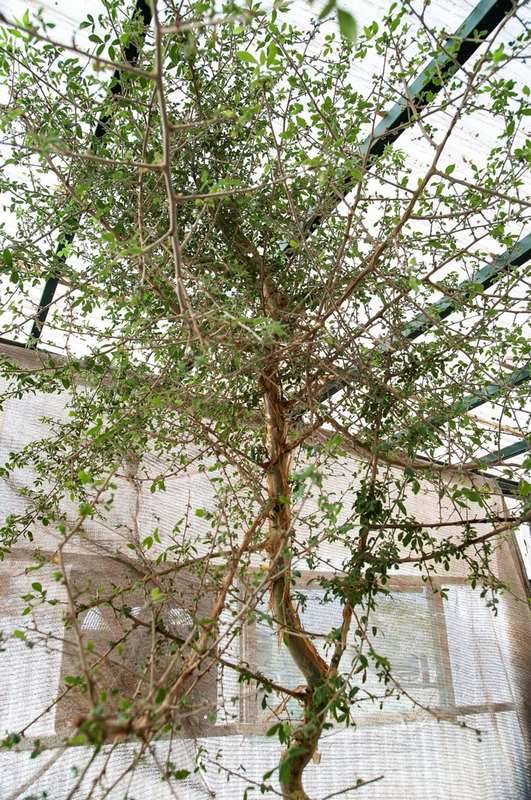
Pictured: The tree, now 14 years old.
Dr. Sallon and her team thought it was an extinct species known from history as Judean Balsam, but the best way to confirm that suspicion would be to have some aromatic traces similar to the resins of the myrrh tree to which it is related. However, no such fragrant compounds were detected.
Instead, the chemical analysis of the leaves identified a group of phytochemicals known as guggulterols which have been observed in a related species called Commiphora wightii that’s known to possess certain cancer-fighting properties in its resin.
A medicinal balm, the origin of which is not known, is mentioned in multiple historical texts including the Bible as ‘tsori,’ and rather than the fragrant Judean Balsam, it’s this tsori that Dr. Sallon and her team believe they have found.
They must wait until the tree, now 14 years old, produces flower or fruit to know for sure if it’s an extinct species, and if so, how to perhaps keep it alive.
Dr. Louise Colville, senior research leader in seed and stress biology at Royal Botanic Gardens, Kew, in London who wasn’t involved in the research, told CNN that it was a major accomplishment to grow a seed that old and possibly lead to a resurrection of this Biblical botanical.
“What’s surprising in this story is it was just a single seed and to be able to have one chance for that to germinate is extremely lucky,” she said.
“Working in a seed bank, seeing the potential for that extreme longevity gives us hope that banking and storing seeds that some at least will survive for very long periods of time.”"
-via Good News Network, October 8, 2024
--
Note: This is such a good demonstration of why seed banks are so important!! They give us such real and massive hope for deextinction and the revival of endangered species.
#botany#plant biology#endangered species#extinct species#deextinction#ancient medicine#jerusalem#biblical#medicinal plants#seeds#seed bank#good news#hope#paleobotany
9K notes
·
View notes
Text
Multiple attempts to reintroduce captive-born ‘alalā to Hawaii’s Big Island have been unsuccessful, in large part because of the ‘io, or Hawaiian hawk, the ‘alalā’s last surviving natural predator. But now new hope is taking wing: a fresh class of five young ‘alalā has been released into the wild on the slopes of the Haleakalā volcano on the island of Maui, where ‘io are absent.
3K notes
·
View notes
Text
I need you all to appreciate how crazy it is to have watched the scimitar horned oryx go from a poster child for "it only exists in zoos" to merely endangered (not even critically endangered!) over my lifetime.
So many heroic people contributed ridiculous amounts of time and effort to make this captive breeding and reintroduction effort a success.
#conservation#biodiversity#good news#hope#reintroduction#endangered species#animal conservation#zoos prevent extinction#captive breeding#environment#positive news#positivity
3K notes
·
View notes
Text
Culture Shock
Look, Danny knows not all of the ghosts from the Zone are human, ok?
Skulker is an alien, Wulf is from another dimension, and Frostbite's ancestral world don't even have planets.
You can meet any ghost from any world and any time period, it's only one of the infinite weird things about the Realms.
So it wasn't a big deal when Danny asked Walker to teach him his mother tongue. Just an attempt to reduce the communication error with the guy, and maybe an effort to get to know his Zone neighbors better.
Generic ghost speak can only get them so far after all.
And ok, Danny wasn't expecting to get actual language books and fucking homeworks from the warden, but whatever. Walker is stuffy like that. It's actually pretty sweet of him to give Danny all of these materials, and Danny can appreciate that.
It might have, unfortunately, slipped Danny's mind to ask more about Walker's origins. Although to be fair, learning an alien language wouldn't be a problem normally, it shouldn't be.
If not for that cursed Fenton luck.
How in the realms is Danny supposed to know Walker is Kryptonian??? Walker acts nothing like Superman, how is Danny supposed to connect the two dots?!
Shit, how do he even start to explain this when Superman is knocking on his dorm window??
#kryptonian walker au#Danny: alright time to practice my pronunciation#Superman: wait why is there a new voice speaking my extinct language... are they learned the alphabet??#dpxdc#dcxdp#danny fenton#superman#danny phantom#clark kent
4K notes
·
View notes
Text
This is such a cool story! Conservation of endangered species cants heavily toward animals and then plants, but you rarely see efforts to try to help endangered fungi, lichenized or otherwise. Part of this is because many fungi are very difficult to propagate, particularly those that have mycorrhizal relationships with plants, and so the best way to save them is to protect critical habitat for those species. Moreover, fungi that produce fruiting bodies like mushrooms are only really easy to observe during their relatively short fruiting season, so unless you're searching the soil or other substrate for DNA traces, your window to actually survey rare fungi is quite short.
But lichens are different. They persist year after year, and so are easier to observe. Growing them is another story, though; most people who give it a try put fragments of a given lichen on a favorable substrate in a controlled environment and hope for the best. However, success is relatively rare in the long term as lichens are quite persnickety about their growing conditions.
So what about just moving the whole substrate? If you have lichens that conveniently grow on tree branches you could cut off piece of branch and then attach them to branches of the same species of tree elsewhere at the same height/sun exposure/humidity level, and hope that the lichens continue to produce spores that then find favorable substrates locally. But it's tougher to chip off chunks of rock and move them to new places, especially if you don't want them getting kicked around.
So it's really fascinating that these conservationists tried out all sorts of different glues to find the most lichen-friendly ones, and then glued them to new substrates in old parts of their range in the hope that they'll use their rhizines to attach themselves to their new homes. It shows how much detail we have to go into in habitat restoration and species conservation to try to replicate the best conditions for a given species to thrive, and how we can't just offer degraded habitats to our wildlife of various sorts and hope that they find it acceptable. Lichens like various Parmelia species or Evernia prunastri may not be as picky in their substrates, but for a rarer species like Gyalolechia fulgens, our task is to give them their Goldilocks substrate--just right. And sometimes helping them along involves a little bookbinding glue.
#lichens#fungi#endangered species#extinction#conservation#restoration ecology#habitat restoration#nature#wildlife#environment#environmentalism#scicomm#good news#positive news#bookbinding#books#ecology#hopepunk
1K notes
·
View notes
Text
Chel snakehead (also known as Channa amphibious)

A rare fish species thought to be extinct for 85 tears was just rediscovered in India. The last sighting of the Chel snakehead (also known as Channa amphibious) was recorded from specimens collected between 1918 and 1933 in the Himalayan region of India, leading scientists to believe the species had died out. “Commonly known as the Chel Snakehead, this large and vibrant species is distinguished by chrome-yellow to orange stripes, a bright neon patch beneath the eye, and the highest number of lateral-line scales among all snakeheads of the Gachua group,” says Thackeray Wildlife Foundation.
#Chel snakehead#fish#good news#india#marine life#ocean life#sea life#sea creatures#endangered species#science#environmentalism#environment#nature#animals#conservation#critically endangered#endangered animals#rediscovered species#extinction
1K notes
·
View notes
Text
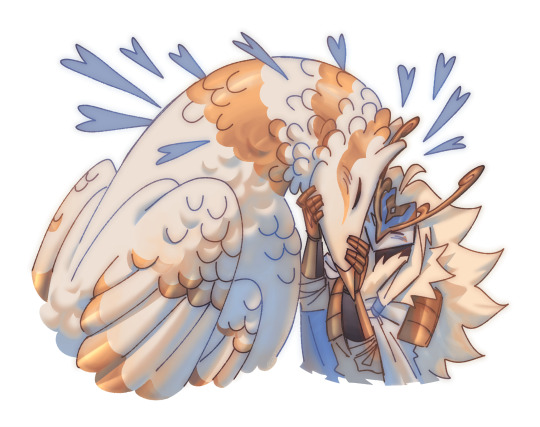
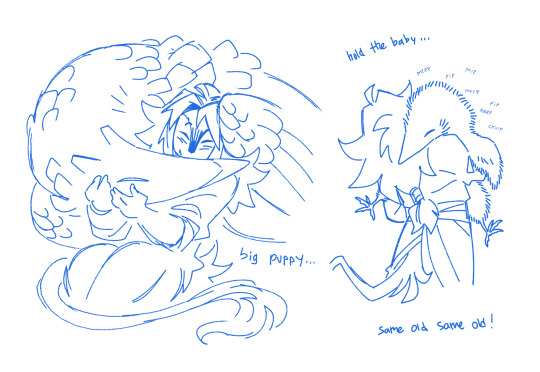
been thinking about hymnhearts ..
#happy new year!#ill be pretty busy with other things but imagine me celebrating#just waiting for fortune to stop on by~#sky children of the light#sky cotl#sky: cotl#sky:cotl#skycotl#sky#sky: children of the light#i had hymns be extinct bcus we dont see them at all in modern day sky#but i think i will revive them... for ilaw..#speculative biology#spec bio#gay bird (ilaw)#thatskygame
412 notes
·
View notes
Text
Good News - July 22-28
Like these weekly compilations? Tip me at $kaybarr1735 or check out my new(ly repurposed) Patreon!
1. Four new cheetah cubs born in Saudi Arabia after 40 years of extinction

“[T]he discovery of mummified cheetahs in caves […] which ranged in age from 4,000 to as recent as 120 years, proved that the animals […] once called [Saudi Arabia] home. The realisation kick-started the country’s Cheetah Conservation Program to bring back the cats to their historic Arabian range. […] Dr Mohammed Qurban, CEO of the NCW, said: […] “This motivates us to continue our efforts to restore and reintroduce cheetahs, guided by an integrated strategy designed in accordance with best international practices.””
2. In sub-Saharan Africa, ‘forgotten’ foods could boost climate resilience, nutrition

“[A study published in PNAS] examined “forgotten” crops that may help make sub-Saharan food systems more resilient, and more nutritious, as climate change makes it harder to grow [current staple crops.] [… The study identified 138 indigenous] food crops that were “relatively underresearched, underutilized, or underpromoted in an African context,” but which have the nutrient content and growing stability to support healthy diets and local economies in the region. […] In Eswatini, van Zonneveld and the World Vegetable Center are working with schools to introduce hardy, underutilized vegetables to their gardens, which have typically only grown beans and maize.”
3. Here's how $4 billion in government money is being spent to reduce climate pollution

“[New Orleans was awarded] nearly $50 million to help pay for installing solar on low to middle income homes [… and] plans to green up underserved areas with trees and build out its lackluster bike lane system to provide an alternative to cars. […] In Utah, $75 million will fund several measures from expanding electric vehicles to reducing methane emissions from oil and gas production. [… A] coalition of states led by North Carolina will look to store carbon in lands used for agriculture as well as natural places like wetlands, with more than $400 million. [… This funding is] “providing investments in communities, new jobs, cost savings for everyday Americans, improved air quality, … better health outcomes.””
4. From doom scrolling to hope scrolling: this week’s big Democratic vibe shift

“[Democrats] have been on an emotional rollercoaster for the past few weeks: from grim determination as Biden fought to hang on to his push for a second term, to outright exuberance after he stepped aside and Harris launched her campaign. […] In less than a week, the Harris campaign raised record-breaking sums and signed up more than 100,000 new volunteers[….] This honeymoon phase will end, said Democratic strategist Guy Cecil, warning the election will be a close race, despite this newfound exuberance in his party. [… But v]oters are saying they are excited to vote for Harris and not just against Trump. That’s new.”
5. Biodegradable luminescent polymers show promise for reducing electronic waste

“[A team of scientists discovered that a certain] chemical enables the recycling of [luminescent polymers] while maintaining high light-emitting functions. […] At the end of life, this new polymer can be degraded under either mild acidic conditions (near the pH of stomach acid) or relatively low heat treatment (> 410 F). The resulting materials can be isolated and remade into new materials for future applications. […] The researchers predict this new polymer can be applied to existing technologies, such as displays and medical imaging, and enable new applications […] such as cell phones and computer screens with continued testing.”
6. World’s Biggest Dam Removal Project to Open 420 Miles of Salmon Habitat this Fall

“Reconnecting the river will help salmon and steelhead populations survive a warming climate and [natural disasters….] In the long term, dam removal will significantly improve water quality in the Klamath. “Algae problems in the reservoirs behind the dams were so bad that the water was dangerous for contact […] and not drinkable,” says Fluvial Geomorphologist Brian Cluer. [… The project] will begin to reverse decades of habitat degradation, allow threatened salmon species to be resilient in the face of climate change, and restore tribal connections to their traditional food source.”
7. Biden-Harris Administration Awards $45.1 Million to Expand Mental Health and Substance Use Services Across the Lifespan
““Be it fostering wellness in young people, caring for the unhoused, facilitating treatment and more, this funding directly supports the needs of our neighbors,” said HHS Secretary Xavier Becerra. [The funding also supports] recovery and reentry services to adults in the criminal justice system who have a substance use disorder[… and clinics which] serve anyone who asks for help for mental health or substance use, regardless of their ability to pay.”
8. The World’s Rarest Crow Will Soon Fly Free on Maui

“[… In] the latest attempt to establish a wild crow population, biologists will investigate if this species can thrive on Maui, an island where it may have never lived before. Translocations outside of a species’ known historical range are rare in conservation work, but for a bird on the brink of extinction, it’s a necessary experiment: Scientists believe the crows will be safer from predators in a new locale—a main reason that past reintroduction attempts failed. […] As the release date approaches, the crows have already undergone extensive preparation for life in the wild. […] “We try to give them the respect that you would give if you were caring for someone’s elder.””
9. An optimist’s guide to the EV battery mining challenge
““Battery minerals have a tremendous benefit over oil, and that’s that you can reuse them.” [… T]he report’s authors found there’s evidence to suggest that [improvements in technology] and recycling have already helped limit demand for battery minerals in spite of this rapid growth — and that further improvements can reduce it even more. [… They] envision a scenario in which new mining for battery materials can basically stop by 2050, as battery recycling meets demand. In this fully realized circular battery economy, the world must extract a total of 125 million tons of battery minerals — a sum that, while hefty, is actually 17 times smaller than the oil currently harvested every year to fuel road transport.”
10. Peekaboo! A baby tree kangaroo debuts at the Bronx Zoo

“The tiny Matschie’s tree kangaroo […] was the third of its kind born at the Bronx Zoo since 2008. [… A] Bronx Zoo spokesperson said that the kangaroo's birth was significant for the network of zoos that aims to preserve genetic diversity among endangered animals. "It's a small population and because of that births are not very common," said Jessica Moody, curator of primates and small mammals at the Bronx Zoo[, …] adding that baby tree kangaroos are “possibly one of the cutest animals to have ever lived. They look like stuffed animals, it's amazing.””
July 15-21 news here | (all credit for images and written material can be found at the source linked; I don’t claim credit for anything but curating.)
#hopepunk#good news#cheetah#extinct species#africa#nutrition#food#farming#gardening#pollution#climate#climate change#climate crisis#democrats#us politics#us elections#kamala harris#voting#recycling#biodegradable#technology#salmon#habitat#fish#mental illness#mental health#substance abuse#hawaii#electric vehicles#zoo
857 notes
·
View notes
Text

In a deeply disturbing finding that has sent shockwaves throughout the nation and the world, officials from the U.S. Fish and Wildlife Service confirmed Thursday that cows have gone extinct.
After fielding numerous questions from the public about where all the cows had gone, the federal agency reportedly conducted an in-depth survey of dairy farms, cattle ranches, and open pasture land across six continents, eventually concluding that not a single member of the domesticated ungulate species remains anywhere on the planet. Full Story
362 notes
·
View notes
Note
s2 gihun with s1 characters PLEASE



wait i love this concept omfg
#TESTING OUT A NEW BRUSH BTW. KINDA FUCKIN WITH IT. lowkey messing with my style too we'll see where it goes#i might do more of s2 gi-hun with the rest of the s1 cast but i wanted to do sae-byeok n sang-woo for sure cuz i thought those were the#most interesting avenues to explore here#for sae-byeok and gi-hun im thinkin abt how they would end up working together since gi-hun now also has trust issues#two black cats fr#maybe they cancel each other out LMFAOOOO#real talk. maybe sae-byeok hangs around his general area lowkey spying on him after he announces hes played before#tryna see if she can gain anything from it#starts wanting to bounce maybe halfway thru the games and figures gi-hun is her best bet? idk#idk bro. just know that sae-byeok and gi-hun are father and daughter in every universe#the reason this ask took a few days to answer is cuz i was literally thinking abt s2 gi-hun with sang-woo all weekend#sang-woo would be TWEAKING bro#s he attracted to gi-hun taking charge and being so serious? yes.#is he also tweaking out because hes Not used to this dynamic between him n gi-hun and also isnt the most knowledgeable person in the room#YES.#he wants to hit but his survival instincts and multiple complexes are screaming at him 💔#he and gi-hun are having a self-loathing off tbh. its not pretty#holy shit this was a yapfest SORRY YOU CAUSED AN EXTINCTION LEVEL EVENT INSIDE MY BRAIN#squid game#squid game fanart#seong gi hun#cho sang woo#kang sae byeok#seong gihun#cho sangwoo#kang saebyeok#my art#doodle#fanart#requests
134 notes
·
View notes
Text
"Despite being arguably the most famous island chain in the world in terms of biodiversity, the Galápagos Islands are still surprising scientists today.
A bird seen and recorded by Charles Darwin on his visit to Floreana island in 1835 has been observed in the wild there for the first time in 190 years.
Darwin’s observations from the small, south-central island in the volcanic chain included the presence of a small, secretive bird called the Galápagos rail (Laterallus spilonota).
Just two years ago, several organizations began work on the large-scale Floreana Island Restoration Project. By removing invasive species that devastated native wildlife for generations, the local environment once again became a haven for species to recover and thrive.
The Galápagos rail, a land-bird endemic to the archipelago, has been severely impacted by these invasive species. It dwells on the ground, is extremely vulnerable to predators, and relies on dense, lush vegetation to hide in. But despite these dangers, the rail has proved to be a resilient and resourceful little bird.
The rails, locally known as Pachays, have been quick to return to restored islands. In 2018, six years after the conservation nonprofit Island Conservation successfully removed invasive species from nearby Pinzón Island, the Rails were among the first locally-extinct animals to reappear—along with other species such as the cactus finch.
It hasn’t been long since the Floreana Island Restoration Project began, but the rails have already repopulated it.
During their most recent annual landbird monitoring expedition on the island, teams from the Charles Darwin Foundation and Ecuador’s state agency for managing the archipelago recorded the bird’s presence at three distinct sites.
The birds were present and away from human habitation and agriculture, in a grassland shaded by guava trees. Confirmed findings include six acoustic records, two visual sightings, and one photograph. And it isn’t a coincidence that they’re back now—the site has been monitored for the Galápagos rail consistently since 2015, and this is the first year they’re back.
“The rediscovery of the Galápagos rail confirms what we’ve seen on islands worldwide—remove the invasive threats, and native species can recover in remarkable ways,” said Island Conservation’s Conservation Impact Program Manager Paula Castaño in a statement.
“This is an incredible win for Floreana, and fuels our excitement about what other native species might resurface as the island continues its journey toward ecological recovery.”
Next, scientists must use genetic sampling to determine whether these newly recorded birds are from a self-reintroduced lineage or whether there was a tiny population of rails that survived, undetected, for 190 years.
Island Conservation details how that’s not unheard of: on nearby Rábida, the organization’s restoration efforts led to the rediscovery of a species of gecko that was only known to science through subfossil records dated more than 5000 years old. They’d been living on the island in very low numbers for hundreds of years, but it was only once holistic restoration had taken place that they were able to increase their numbers to detectable levels.
MORE NEWS FROM THIS FAMOUS PLACE: 500 Giant Tortoises Reintroduced to Four Galapagos Islands in 2023
With a local population already establishing itself, chances are good for a successful reintroduction. Soon, it’s hoped, Floreana’s grasslands will be home to a large, thriving colony of rails.
“It gives us hope that there might be even more ‘extinct’ Galápagos species to find,” the statement read.""
-via Good News Network, March 3, 2025
#galapagos#galapagos islands#birds#birdblr#endangered species#extinction#conservation#extinct#ecosystem#wildlife conservation#good news#hope
662 notes
·
View notes
Text
when hayley williams said "because it has to be so lonely to be the only one who's holy" and when she said "next time you point a finger i'll point you to the mirror" and when she said "you say that i've been changing that i'm not just simply aging" and when she said "just keep on cramming ideas down my throat" and when she said "you don't deserve a point of view if the only thing you see is you"
#will queue welcome your extinction in the morning rays?#paramore#pmore#hayley williams#zac farro#taylor york#brand new eyes#playing god
219 notes
·
View notes
Text
more about og tue timeline twins danny and dan/jamie
very touchy with each other. you might even say. ccclingy. its to be expected, they're two halves of a whole after all and all they've got of each other. worryingly co-dependent. do not separate. ever.
Danny was really weak and sick after the initial separation, and was for a while after. Jamie knew internally that if Danny died, he'd take the whole world with it. He was the one sole caretaker for him while he got better -- not for lack of trying on Vlad's part, but without his ghost powers he was nothing more than a feeble (albeit handsomely rich) man, and James looked ready to bite his head off if he got within ten feet of either of them.
Vlad is intimately aware that James (or Danny, if he tried) could snap his spine in half like a twig, and is uncomfortably aware of his own lack of ghost half now. It makes him feel self-conscious and exposed, so he never fully returns back to "cocky and self-assured billionaire Vlad Masters". Making deals with other brands feels a lot harder now that he can no longer possess them anymore.
Speaking of, he very quickly has to come up with a cover story as to why there's now a James Daniel Fenton to the public, when no records whatsoever of him existing existed prior. Lots of forging false government documents on his end. James and Danny do not help because it's his fault this happened in the first place.
(Regardless of whether or not Danny actually willingly chose to rip out his ghost half/humanity in canon is true, or if that was Vlad Masters speaking out of his ass, a large part of the blame still falls on Masters.)
(As his primary caretaker and guardian, it's his responsibility to ensure the health and safety of his charge, and since Danny was in clear emotional duress at the time, it can be argued that he was not in the mental state to make such a decision. And, allegedly, couldn't do it on his own which is why he asked Vlad for help.)
I chose "James" as Dan's name since it's a popular fanon middle name for Danny, and since he's half of Danny, it felt like it just made sense lol. Also because of the ensuing comedy of the two of them introducing themselves as "James Daniel Fenton" and "Daniel James Fenton". It's got the same energy as "danny with a y" and "danny with an i" and it's the exact kind of name bullshit you expect parents to give their twins.
I don't have their exact personalities down, but something I am actively writing into this au's bible is that I think Danny should be the quiet and (ig technically) meaner one. There's a lot to go into about interpretations for ghosts, halfas, and the incident itself, but TL:DW; Danny is technically soulless, or at the very least missing half of his soul (altho Jamie is too just in a different direction).
Pair that with the trauma of losing his family in front of him + having his ghost half ripped out + all the trauma he would've sustained as a hero, and he's not doing too hot mentally! i think if the twins met good timeline!Danny, Danny would've mistaken Danny for Dan and Jamie for the original half.
He comes off to others as pretty apathetic and indifferent to a borderline terrifyingly calm degree. He doesn't go out of his way to insult people, but he also doesn't care enough to consider the other party's feelings so he doesn't filter himself, which makes him come off as rude. The only times he looks truly comfortable is when he's near Jamie or talking to him.
His standoffish, ice prince demeanor makes Jamie look like a saint in comparison. When really he's not all that much better? He's more outwardly emotional than Danny, whether that be positive or negative, but at the end of the day he doesn't trust or care about anyone else any more than Danny does, and he's got a bit of a sadistic streak. Danny reigns him in when he starts becoming too destructive.
(Which I think makes sense. Danny asked Vlad to rip out his ghost half specifically so he could stop feeling his human emotions. Dan, despite his monotone voice, does exhibit emotions. He's smug when he asks Valerie if he likes his ghostly wail, sardonic when he reunites with Sam and Tucker, annoyed, shocked at Danny's ghostly wail, etc. He enjoys wreaking destruction and chaos.)
(If Danny had survived his encounter with Dan and if Vlad was successful, then I imagine he'd be rather apathetic to his other half as a whole. That'd be interesting.)
Overall though they're both hurt, bitter, and distrustful of the world around them, with abandonment issues a mile wide. They can get better and they can heal, but it takes time and patience and proper support.
On the DPxDC side of things, they do genuinely hold some kind of respect or regard for Bruce. They also don't become vigilantes for a while. Neither of them are jumping at the bit to enter heroism again, not when it was heroism that killed their family in the first place.
In fact when they find out Bruce = Batman they think he's foolish for it. They think its a fool's errand, and they've been so spurned by their time as Phantom that for a few weeks, Jamie even refused to call Bruce anything but Sisyphus. Danny called him Tantalus, and the two of them had a faux-argument about which one was more accurate.
Bruce does, though, worm his way into both of their hearts, and that's like, the main reason they become vigilantes to join him. So that they could keep him safe and not because of any desire to return to the heroic life. Relearning to care and finding satisfaction in helping others was an unintentional side effect.
(Bruce is so very smug)
Essentially:
The Twins: this is our squishy and fragile adoptive father. If anything happened to him, we're becoming mass extinction events.
Bruce: Nnno.
#danny fenton is not the ghost king#dpxdc#dp x dc#dpxdc crossover#dp x dc crossover#dpxdc au#danny phantom#the twins au#dan phantom#batman and his no-good terrifying little bodyguards. they're both like 5'2 and weigh 90lbs soaking wet and are capable of great violence#he can scruff them both with both hands. they're like two wet cats.#bruce: these are my children Daniel and James | the twins: *emanating little orphan tom riddle energy from behind him*#danny can experience emotions btw they're just dulled(??) to an extent. he doesn't feel them as intensely as Jamie does. in some cases#he knows he should be feeling SOME kind of emotion he just doesn't. being around Jamie helps amplify them. some kind of feedback thing#Jamie is a mischief maker. enjoys wreaking subtle chaos on other people especially people of his ire. laughs at other's misfortune.#neither of them are all that sympathetic when bruce takes them in. but they dO like. like~ him when he does. in some way. they prefer him#over vlad at least. by the time they become vigilantes they genuinely care about him. if not as family then at the very least as a friend.#which means. congrats bruce! you've unlocked the [ viciously protective sons ] perk! have fun with your mini ragnaroks :)#cannot express enough that the twins DO like and respect bruce. there's a genuine care and mutual friendship/relationship there.#yeah they dont need bruce's permission (technically) to be vigilantes but with the way they're set up why WOULD they lmao.#they have no incentive to return to the hero life and in fact comma have the incentive to do the exact opposite and avoid it.#so i give them believable incentive >:]#batdad aus go brrrrrrrr#referring to dan as a 'mass extinction event' is my new favorite way to refer to him <33 bc its technically true
141 notes
·
View notes
Text
Endangered Species Sightings from This Year
This is thought to be the first time in over 20 years that a blue whale was spotted off the Coast of Massachusetts.
I highly recommend watching the video and listening to the reaction of the people on the whale watching boat--the cheers and emotion in some of their voices, especially the woman saying "I'm trying not to" when someone jokingly tells her not to cry.
This is the first time ever that a mother clouded leopard with two cubs has been spotted on a game cam!
"After being considered regionally extinct for over a century, giant anteaters have been spotted roaming once again in Brazil's Rio Grande do Sul state. Scientists have concluded these returned natives ventured over from Argentina's Ibera Park, where conservationists have released around 110 rescued and captive-bred anteaters since 2007."
Over 100 years and the anteaters are finally coming home!
#conservation#animal conservation#biodiversity#good news#environment#whale conservation#wolverine conservation#anteater conservation#rainforest conservation#ocean conservation#hope#optimism#radical optimism#positivity#ecoanxiety#climate anxiety#cat conservation#clouded leopard conservation#zoos prevent extinction
3K notes
·
View notes
Text
#2545 - Hieraaetus moorei - Haast's Eagle
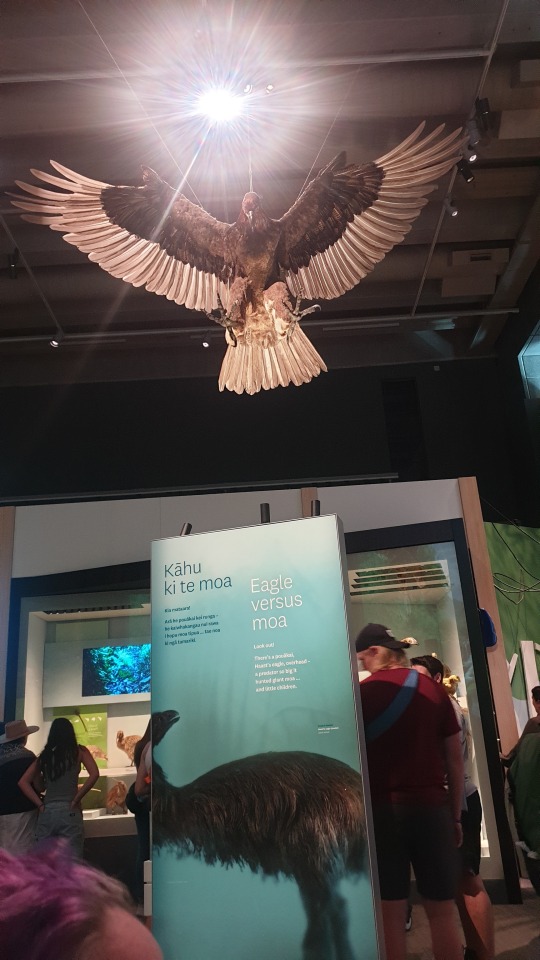
The largest eagle ever known to exist. Almost certainly the pouākai of Māori mythology. They certainly would have paid attention to it since it was big enough to consider humans as particularly stupid Moa who stood around in the open.
Here's some talon marks in a Moa hipbone.
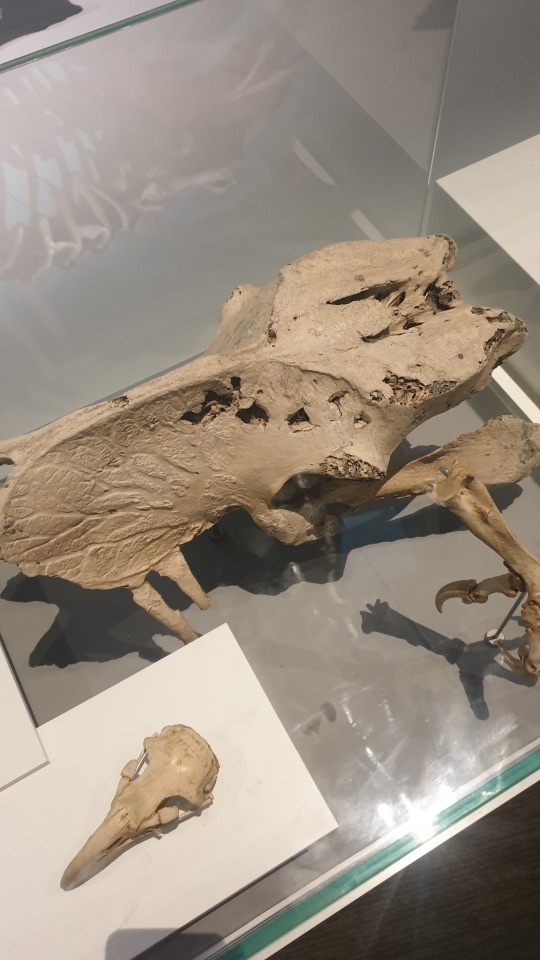
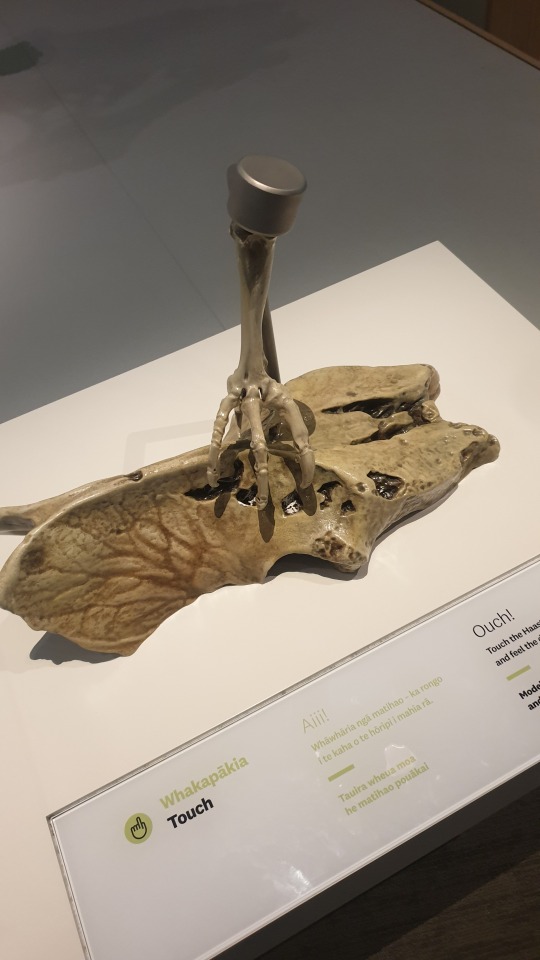
Originally described as Harpagornis moorei by Julius von Haast in 1871, from the Greek harpax, meaning "grappling hook". DNA analysis later showed that this bird was actually related to the much smaller little eagle (Hieraaetus morphnoides) and booted eagle (Hieraaetus pennatus) and not the large wedge-tailed eagle (Aquila audax) of Australia.
It probably evolved from the little eagle 1.8 million to 700,000 years ago, which means it increased ten to fifteen times in size - the largest, fastest evolutionary increase in average weight of any known vertebrate species. There were no other large predators in New Zealand, and an abundance of giant flightless prey.
It had a relatively short wingspan for a bird in its weight class. Females were estimated to span 2.6 m, possibly up to 3 m. It seems likely they pursued prey into dense forests, like the goshawks and harpy eagle.

The eagles most likely became extinct in the 1400s, after the Māori hunted their usual prey to extinction. Maori oral tradition about the birds persist to today, with late 1800s records saying it had red, black and white plumage with "black feathers tinged with yellow or green" and "a bunch of red feathers on its head".
Te Papa, Wellington, New Zealand.
#Hieraaetus#Harpagornis#haast's eagle#extinct species#new zealand bird#giant eagle#pouākai#te papa#wellington#Accipitridae
147 notes
·
View notes